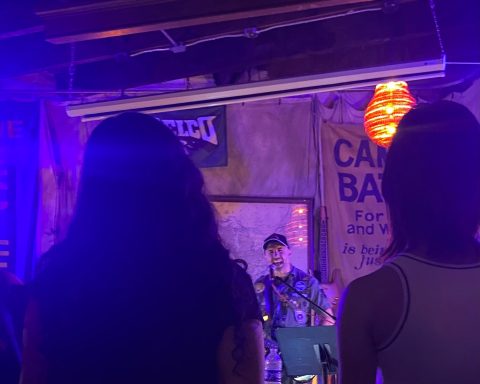Editor’s note: This article was initially published in The Daily Gazette, Swarthmore’s online, daily newspaper founded in Fall 1996. As of Fall 2018, the DG has merged with The Phoenix. See the about page to read more about the DG.
When Brent Stanfield ’14 attended the activities fair during their freshman year, they walked up and down the tables, searching fruitlessly for a group or club for students who identify as Native. But at this year’s fair, thanks to Stanfield and Daniel Orr ’16, students with a similar goal were able to stop at the table of the revitalized Native American Student Association (NASA).
NASA has existed nominally for quite some time at Swarthmore. In fact, it was one of the founding groups of the Intercultural Center (IC). Over the years, the group’s membership has fluctuated, and the group has not always been active.
Stanfield and Orr hope to change that and invigorate the group to support Native-identifying students, build community, and raise awareness and visibility of Native issues on campus. Last Saturday, they signed up about 20 students, and the group will begin to meet in the coming weeks.
“Last year I tried again, and we had a closed dinner and we had about six people come and it was really good, so I decided to go forward,” said Stanfield about rebuilding the group. “This year, we are making it very clear that it is an open group, partly because I think one of the big issues was visibility—people not knowing it was a club, not even thinking about whether or not there were Native students on campus, let alone thinking about if there was a group of students to speak for them in larger structural contexts.”
NASA is open group, so will be comprised of students who join for a multitude of different reasons. “It is students who identify as Native—but Native identity can be very complicated and very difficult to claim,” Stanfield said. “That is part of the reason why it is open.” In addition to providing support for Native students, NASA will serve as a space to explore Native culture. “I also know people who aren’t native but who grew up on or near reservations and share a lot of that culture. It is also about being able to share that with others.”

For Orr, the other leader of NASA this year, finding out that there were other Native students on campus made a huge difference in his life at Swarthmore. “I’m from Oklahoma, and I’m Native—I have native family back home,” he said. “Coming here was a bit shocking, being so divorced from all the Native culture that I can feel back home. Meeting Brent was amazing because he is also Cherokee—it was like finding an old friend. Knowing that there was a Native community and a Native presence here really made it a lot easier to be comfortable with Swarthmore.”
Both Stanfield and Orr hope that other students will look to NASA to find that support. “In the past few months, we’ve been talking so much about diversity and the lack thereof in a lot of categories,” Orr said. “One thing I’d love to see is Native diversity being entered into that. Natives are so underrepresented in the academic sphere.”
Both leaders also acknowledge that there will be many issues to tackle as the group gets going. Ignorance on Native issues is widespread and can lead to misunderstandings and problematic questions. Orr and Stanfield were reminded of this even from comments made while tabling at the activities fair. “One of the things I’ve learned here especially in the last year,” Orr said, “is that lot of the etiquette that we’ve grown up understanding when it comes to Native culture people here don’t understand. It’s not okay to ask how much blood you are. You can’t just assume that we do all these things like smoking peyote, or going to powwows. There are a lot of stereotypes.”
When speaking about Native issues in NASA, Stanfield and Orr emphasized the nuance that will be inherent in the conversations. “It can be difficult because there is such a diversity within Native Americans,” Stanfield said. “I can speak from my cultural experience and my cultural knowledge, but that might contradict what someone else grew up with.”
Another layer of complexity will come from the students who do not identify as Native. “It will be nice having people who will be interested and have questions—I just hope that Brent and I will be able to answer them properly,” Orr said.
This year, NASA hopes to bring speakers to campus, look into the lack of Native representation in the faculty and student body at Swarthmore, and raise general awareness of Native issues. They have been approached about a possible Paces Takeover and are exploring the idea of a Native Cultural Week. Goals include ensuring the legacy and permanence of NASA, questioning the absence of a Native Studies Program, and including Native students in campus discussions on diversity.
With new members and new objectives, this year will undoubtedly prove different for NASA, but Orr and Stanfield are prepared to take the changes in stride. In Orr’s words, “We have to see what happens and deal with it as it comes.”















